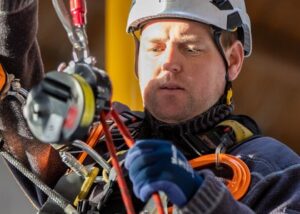Learn more about GWO Slinger Signaller and GWO Crane and Hoist.
The Global Wind Organisation (GWO) sets international standards for safety training in the wind energy industry. Among its key training standards are the GWO Slinger Signaller and GWO Crane and Hoist modules, which focus on safety procedures and best practices when working with cranes, hoists, and other lifting equipment. These training standards are vital for preventing accidents, ensuring the safe movement of materials, and protecting the workforce in wind turbine environments. This article explores the content and importance of these two GWO training standards, along with their critical role in enhancing safety and operational efficiency in the wind energy sector.
1. Overview of GWO Slinger Signaller Training
a. Purpose of the Training
The GWO Slinger Signaller training module is designed to equip workers with the necessary skills to safely guide and control the lifting and movement of heavy loads using slings, chains, or other rigging equipment. The role of a slinger signaller is crucial in environments where wind turbines are constructed, maintained, or repaired, as the safe transport of heavy equipment and components is a regular occurrence.
b. Training Content
The GWO Slinger Signaller course is typically divided into theoretical and practical components. Participants are trained in the following areas:
- Roles and Responsibilities: Understanding the duties of a slinger signaller, including communication with crane operators, riggers, and other team members.
- Lifting Principles: The fundamentals of lifting operations, such as the physics of load distribution, lifting angles, and the capabilities and limitations of rigging equipment.
- Types of Lifting Equipment: Overview of slings, shackles, chains, hooks, and other gear used in lifting operations. The course also emphasizes the importance of selecting the right equipment for specific tasks.
- Communication Protocols: Learning the proper hand signals and radio communication methods to guide crane operators effectively. The ability to communicate clearly is essential to prevent misunderstandings that could lead to accidents.
- Load Handling: Practical instruction in the safe rigging and unrigging of loads, ensuring they are properly balanced and secure before lifting.
- Hazard Awareness: Identifying and mitigating risks such as environmental factors (wind, rain, or uneven terrain) that could affect lifting operations.
c. Assessment and Certification
Upon completing the training, participants are assessed on both theoretical knowledge and practical performance. Successful candidates are awarded GWO certification, which is recognized globally in the wind industry.
2. Overview of GWO Crane and Hoist Training
a. Purpose of the Training
The GWO Crane and Hoist training module focuses on the safe operation of cranes and hoists in the wind industry. Cranes and hoists are often used to lift heavy components like turbine blades, tower sections, and other essential parts of wind turbines. This training ensures that workers who operate or work near these machines understand how to do so safely, avoiding accidents that could lead to severe injuries or equipment damage.
b. Training Content
The GWO Crane and Hoist course covers both operational and safety elements, providing participants with a comprehensive understanding of crane and hoist operations. Key topics include:
- Crane and Hoist Mechanics: Participants learn about different types of cranes (mobile, tower, overhead) and hoists used in the wind industry. The training explains how these machines function, their load limits, and safety features.
- Safe Lifting Practices: Instruction on best practices for safely operating cranes and hoists, including load assessment, rigging inspections, and ensuring the lifting path is clear of obstacles.
- Pre-Operational Checks: Participants are taught how to conduct safety checks on cranes and hoists before use, ensuring that the equipment is in good working condition and that all safety mechanisms are functioning properly.
- Emergency Procedures: Training includes emergency protocols, such as how to safely lower a load in case of equipment failure, or what to do in the event of a power outage or mechanical issue.
- Environmental Considerations: Wind turbines are often located in remote or challenging environments, where weather conditions like high winds, rain, and ice can affect crane and hoist operations. Trainees learn how to assess these risks and adjust operations accordingly.
- Operator Communication: Similar to the Slinger Signaller training, this module places significant emphasis on communication between crane operators, signallers, and ground crew. The correct use of hand signals and radio communication is essential for safe operations.
c. Assessment and Certification
Like the Slinger Signaller course, participants in the Crane and Hoist training module are evaluated through both theoretical and practical assessments. Upon successful completion, they receive GWO certification, validating their competency in operating cranes and hoists in the wind industry.
3. Why GWO Slinger Signaller and GWO Crane and Hoist Training are Important
The GWO Slinger Signaller and Crane and Hoist training standards play an essential role in ensuring safety and operational efficiency in the wind energy sector. Here’s why they are particularly important:
a. Accident Prevention
One of the most critical reasons for these training standards is accident prevention. The movement of heavy loads is inherently dangerous, especially in environments like wind farms, where high altitudes, strong winds, and remote locations create additional risks. Improperly rigged loads, poor communication, and inadequate knowledge of crane operations can lead to accidents, causing injuries or fatalities. GWO training minimizes these risks by ensuring that workers have the skills and knowledge to handle lifting operations safely.
b. Compliance with Industry Standards
Regulatory bodies like OSHA (Occupational Safety and Health Administration) in the U.S. and other international safety organizations enforce strict regulations regarding lifting operations. Wind industry companies must comply with these regulations to avoid legal repercussions, fines, and reputational damage. GWO-certified workers help companies meet these standards, ensuring that they operate within the legal framework and maintain high safety levels.
c. Enhancing Worker Competence
Both the GWO Slinger Signaller and Crane and Hoist training modules focus on developing worker competence. By receiving specialized training, workers are more capable of handling the complex tasks associated with lifting and moving heavy equipment. This not only reduces the likelihood of accidents but also improves operational efficiency. Competent workers can perform their tasks more quickly and accurately, minimizing downtime and increasing productivity.
d. Protecting Equipment and Reducing Costs
Improper lifting practices can damage expensive equipment, leading to costly repairs and replacements. A dropped turbine blade, for example, could result in significant financial losses and project delays. GWO training ensures that workers know how to rig, signal, and operate cranes safely, reducing the risk of damage to both equipment and the surrounding environment. By preventing such incidents, companies save money and avoid unnecessary downtime.
e. Global Standardization and Portability
One of the key benefits of GWO certification is its global recognition. Workers who complete GWO Slinger Signaller or Crane and Hoist training can take their certifications anywhere in the world, making them highly valuable in the international wind energy market. For companies, hiring GWO-certified workers means that they can trust in their competency and understanding of globally recognized safety standards, regardless of where the wind project is located.
4. Conclusion
In the rapidly growing wind energy sector, safety is of paramount importance, particularly in lifting operations involving heavy and expensive components. The GWO Slinger Signaller and GWO Crane and Hoist training standards address the critical need for proper safety protocols and best practices in these high-risk environments. By ensuring that workers are properly trained, companies can prevent accidents, reduce costs, and enhance both safety and productivity. With GWO certification being recognized globally, these training standards also promote a universal standard of safety that can be applied across wind energy projects worldwide.
Interested in GWO Slinger Signaller and GWO Crane and Hoist?
Click learn more to speak to the STL USA team.




